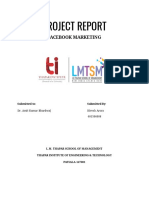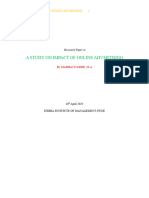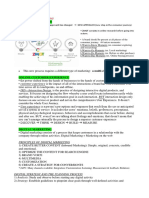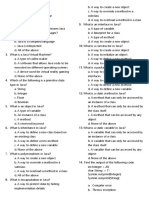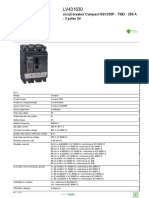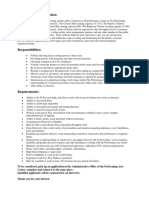Fundamental of Digital Marketing (BDO) 3-I Principle 3) Types of media- paid, earned and owned.
3) Types of media- paid, earned and owned. Audience research- definition and
The 3-I Principle refers to a strategy for managing and optimizing marketing campaigns. benefits
1) Difference Between traditional and digital marketing
1. Inspiration: In marketing, understanding the different types of media is crucial for crafting an effective strategy.
a. The first stage involves inspiring your audience by creating compelling content, Paid, earned, and owned media refer to the various channels and types of exposure a brand can
ideas, and campaigns that resonate with them. have. Each type has its own characteristics, benefits, and challenges.
b. Goal: To generate interest and awareness among your target audience by delivering 1. Paid Media - Paid media refers to any form of advertising or promotion where a brand pays for
the right message at the right time. exposure. This includes various forms of ads that are placed on third-party platforms to reach a
2. Involvement: wider audience.
a. This stage is about engaging the audience further by offering them more relevant Examples:
and personalized content. o Pay-per-click (PPC) Ads (Google Ads, Bing Ads)
b. Goal: To nurture leads and move them closer to conversion by building a o Social Media Ads (Facebook, Instagram, LinkedIn Ads)
relationship. o Display Ads (Banner Ads)
3. Impact: o Sponsored Content (Influencer posts, sponsored blog posts)
a. The final stage involves turning your audience’s interest and involvement into o TV and Radio Commercials
action (purchases, subscriptions, etc.). Benefits:
b. Goal: To drive measurable business outcomes such as sales, lead conversions, or o Immediate Reach: Quickly increases visibility and reach to a targeted audience.
customer retention. o Precise Targeting: Platforms like Google Ads and social media allow for detailed
SMART Objectives audience segmentation based on demographics, interests, and behaviors.
o Scalable: You can adjust the budget and scale ads up or down based on
SMART is an acronym used to describe specific, measurable, achievable, relevant, and time-
performance.
bound goals that are crucial for guiding business and marketing strategies.
o Measurable: Provides measurable results such as clicks, impressions, and
1. S - Specific:
conversions, making ROI easy to track.
a. The objective should be clear and precise, not vague or broad. Define exactly what
you want to achieve. Challenges:
2) Inbound and outbound marketing, 3-I principle, Smart objectives b. Example: "Increase website traffic by 20% in the next quarter." o Can be expensive, especially for competitive keywords or large-scale campaigns.
2. M - Measurable: o Requires continuous investment for sustained results.
a. There should be a way to quantify the goal to track progress and success. 2. Earned Media - Earned media is the publicity a brand gains through public relations
b. Example: "Achieve 1,000 new sign-ups for our email list." efforts, positive customer feedback, and third-party endorsement. It’s not directly paid
3. A - Achievable: for, but earned through the brand's efforts to create valuable content, build relationships,
a. The objective should be realistic and attainable given your resources and or generate word-of-mouth buzz.
constraints. Examples:
b. Example: "Increase sales by 10% in the next 6 months with our current marketing o Media Coverage (press articles, news stories)
budget." o Customer Reviews (positive reviews on platforms like Google, Yelp, or Trustpilot)
4. R - Relevant: o Shares, Mentions, and Tags on social media
a. The goal should be aligned with broader business objectives and add value to the o Word-of-mouth recommendations
organization. o Influencer endorsements (when influencers organically mention or promote a
b. Example: "Improve brand awareness among our target demographic (ages 25-40) brand)
by partnering with influencers." Benefits:
5. T - Time-bound: o Credibility: Earned media is often more trustworthy because it comes from
a. The objective should have a clear deadline or timeframe for completion. independent third parties (e.g., media outlets, influencers, or customers).
b. Example: "Launch a new product within the next 3 months."
o Cost-Effective: It doesn't require direct payment, although it may involve Benefits of Audience Research: 2. Middle of the Funnel (MOFU)
investments in public relations, content creation, or relationships. 1. Improved Targeting: Audience research helps identify specific segments of Consideration Stage: Prospects actively evaluate their options.
o Long-Lasting Impact: Positive earned media can create lasting brand recognition customers, allowing businesses to create targeted marketing campaigns that speak Objective: Nurture leads with detailed and comparative content.
and reputation. directly to the right people, improving conversion rates. 3. Bottom of the Funnel (BOFU)
Challenges: Decision Stage: A smaller, more qualified audience is ready to purchase.
2. Better Content Creation: Understanding what your audience is interested in and
o Difficult to Control: You don’t have full control over how earned media is Objective: Convert leads into customers with persuasive offers.
what content they engage with allows you to create relevant, valuable, and
represented. 5) Benefits of 360 marketing. , E-mail marketing for retention strategies
personalized content that resonates with them.
o Time-Consuming: It takes time and effort to build relationships, generate positive A 360-degree marketing approach ensures that your brand communicates consistently
reviews, and earn media coverage.
3. Optimized Marketing Strategies: Audience research provides valuable data to
help optimize various aspects of your marketing strategy, from pricing and product across all channels, creating a seamless and comprehensive customer experience. This
3. Owned Media - Owned media refers to the channels that a brand controls and owns,
development to promotional channels and messaging. approach integer
such as its website, social media accounts, email list, and blogs. These are platforms
4. Increased ROI: With a deeper understanding of your audience, you can allocate 1. Comprehensive Brand Visibility : Reaches your audience wherever they are,
where the brand has full control over content, messaging, and audience engagement.
marketing resources more efficiently, leading to higher returns on investment (ROI) whether online, on social media, or in physical locations.
Examples:
through better targeting and fewer wasted efforts. 1. Consistent Messaging Delivers a unified message across channels, reinforcing
o Website (company's site, landing pages)
4) Data types used in audience research, The buyer’s journey. buyer's journey funnel. brand identity and building trust.
o Social Media Profiles (Facebook, Instagram, LinkedIn, etc.)
o Email Newsletters (email campaigns) Audience research involves collecting and analyzing various data types to understand your 2. Maximized Reach: By covering multiple channels (TV, email, social media,
o Blog (company blog, product updates) target audience and their preferences, behavior, and needs. These data types can be websites, etc.), it ensures no potential audience is left out.
o Mobile Apps (if owned by the brand) broadly categorized into the following: 3. Better ROI Optimizes the marketing budget by targeting audiences across multiple
Benefits: 1. 1. Demographic Data. touchpoints, improving conversion rates
o Full Control: You have complete control over the content, design, and messaging. 2. Psychographic Data Email Marketing for Retention Strategies
o Cost-Effective: Once you’ve established owned media channels, they don’t require Email marketing is a powerful tool for retaining customers and building long-term
3. Geographic Data
ongoing advertising spend (except for maintenance and content creation). relationships. It allows brands to stay connected with their audience and nurture loyalty.
4. Behavioral Data
o Sustainability: It doesn’t require continuous investment in ads or media buy, unlike
5. Transactional Data Benefits of Email Marketing for Retention
paid media.
6. Interaction Data
Challenges: 1. Direct Communication - Maintains a direct line with customers, fostering
o Building an Audience: It can be time-consuming to build an audience, especially 7. Web Analytics Data personalized engagement.
for new websites, blogs, or social media profiles. 8. Social Media Insights 2. Cost-Effective - Compared to other channels, email marketing has a high ROI and
o Dependence on Other Platforms: For social media, the platform's rules (like 9. Customer Feedback is economical for ongoing communication.
algorithm changes) can affect your reach and engagement The Buyer’s Journey 3. Personalization and Segmentation -messages based on customer preferences,
Audience Research: Definition and Benefit The buyer's journey describes the process customers go through before making a purchase history, and behaviors, increasing relevance and engagement.
Audience research is the process of gathering and analyzing data about the people who purchase. It includes three main stages: 4. Fosters Loyalty - Consistently delivers valuable content, offers, and updates,
make up a brand's target audience. It helps marketers understand the demographics, 1. Awareness Stage building a sense of trust and commitment.
preferences, behaviors, needs, and pain points of potential customers. 2. Consideration Stage 5. Boosts Repeat Purchases - Uses targeted promotions, reminders, or
Methods of Audience Research: 3. Decision Stage recommendations to encourage repeat business.
Surveys and Questionnaires: Collecting feedback directly from your audience. The Buyer’s Journey Funnel
Social Media Analytics: Studying the demographics and behaviors of people The buyer’s journey is often visualized as a funnel, representing how prospects narrow down their
interacting with your brand on social media. options before making a purchase:
Website Analytics: Using tools like Google Analytics to understand how visitors 1. Top of the Funnel (TOFU)
interact with your website. Awareness Stage: A broad audience becomes aware of their problem.
Objective: Attract a large audience with valuable, educational content.
�6) Importance of demographic, psychographic and behavioral data , Passive and 7) Intro to project management-role of a project manager, what is project 8) Components of digital marketing-content, display and video ad Digital marketing
active audience management and benefits comprises various strategies and channels to promote products or services online. Among
Understanding your target audience through demographic, psychographic, and Project management is the application of knowledge, skills, tools, and techniques to the most important components are content marketing, display advertising, and video
behavioral data is essential for creating effective marketing strategies and delivering project activities to meet the project's objectives. It involves balancing competing advertising, each playing a unique role in reaching and engaging the target audience.
demands for scope, time, cost, quality, and resources while addressing stakeholder
personalized experiences. Here's why each type of data is critical: 1. Content Marketing - Content marketing involves creating and distributing valuable,
expectations.
1. Demographic Data - Statistical data that categorizes individuals based on measurable relevant, and consistent content to attract and engage a specific target audience,
Key Components of Project Management:
characteristics. Examples: Age, gender, income, education, occupation, and marital status. ultimately driving profitable customer actions.
1. Scope: Defines what the project will deliver.
Importance:
2. Time: Establishes a schedule and milestones. Key Components of Content Marketing:
o Targeted Marketing: Helps identify the most suitable audience for your product or
3. Cost: Sets the budget and monitors expenses. Blog Posts: Articles that provide insights, tips, or educational value.
service.
4. Quality: Ensures that deliverables meet the required standards. eBooks and Whitepapers: In-depth resources that offer solutions to audience challenges.
o Product Development: Informs product features and pricing strategies tailored to
5. Resources: Manages human and material resources effectively. Social Media Content: Posts, stories, or reels designed for platforms like Instagram,
the audience's economic capacity.
LinkedIn, or Twitter.
o Market Segmentation: Enables marketers to divide the market into groups with 6. Risk Management: Identifies and mitigates potential risks.
Email Newsletters: Curated information delivered to subscribers to maintain engagement.
shared traits, making campaigns more effective. Role of a Project Manager - The project manager is the person responsible for
leading a project from its inception to completion. They ensure that the project meets its SEO-Optimized Content: Articles or web pages tailored to rank high in search engine
2. Psychographic Data - Information about an audience's lifestyle, values, interests, and
objectives while staying within scope, budget, and timeline constraints. results, increasing visibility.
personality traits. Examples: Hobbies, spending habits, attitudes, and motivations.
Importance: Key Responsibilities: 2. Display Advertising - Display advertising uses visual elements like banners,
o Deeper Understanding: Provides insights into why consumers make decisions, 1. Planning: images, and text to promote products or services across websites, apps, and social media
helping craft compelling messages. 2. Team Leadership: platforms. Types of Display Ads:
o Emotional Connection: Aligns your brand with the audience's beliefs and values, 3. Communication: 1. Banner Ads: Static or animated images displayed on web pages.
fostering loyalty. 4. Risk Management: 2. Rich Media Ads: Interactive ads featuring elements like video, audio, or
3. Behavioral Data - Insights into how individuals act, especially their purchasing habits and 5. Monitoring Progress: animations.
interaction with brands. Examples: Purchase history, website visits, social media activity, and app 6. Resource Management: 3. Retargeting Ads: Ads shown to users who previously interacted with your website
usage.
Benefits of Project Management or app.
Importance:
1. Clear Goals and Direction: 4. Responsive Ads: Automatically adjust size, appearance, and format to fit available
o Predictive Insights: Helps anticipate future actions, enabling proactive
2. Efficient Use of Resources: ad spaces
engagement strategies.
o Optimization: Improves marketing efforts by identifying what works best for your 3. Improved Collaboration: 3. Video Advertising - Video advertising involves creating and running video content to
audience. 4. Risk Mitigation: promote products or services. These ads can be integrated into video platforms like
5. Enhanced Quality Control: content. Types of Video Ads:
1. In-Stream Ads:
a. Pre-Roll: Played before a video.
b. Mid-Roll: Played during a video.
c. Post-Roll: Played after a video.
2. Outstream Ads: Auto-played on websites or apps outside of video content.
3. Shoppable Video Ads: Allows viewers to click on products featured in the video to
purchase.
4. Story Ads: Short, vertical video ads on platforms like Instagram and Snapchat.
9) Social media marketing analytics, Porters five forces
Social media marketing analytics involves the collection, measurement, and interpretation
of data from social media platforms to assess the performance of campaigns, understand
audience behavior, and guide decision-making. Analytics play a crucial role in optimizing
strategies for better engagement, conversion, and ROI.
Reach and Impressions:
Reach: The number of unique users who see your content.
Follower Growth: Tracks the increase or decrease in followers over time, indicating
the popularity and effectiveness of your content.
Conversions and Leads: Monitors actions like sign-ups, purchases, or downloads
directly attributed to social media campaigns.
Traffic Metrics: Measures the number of visitors directed to your website via social
media, often analyzed through tools like Google Analytics.
Porter's Five Forces Framework - Developed by Michael Porter, the Five Forces
framework analyzes the competitive environment of an industry to determine its
attractiveness and profitability. It helps businesses understand their competitive position
and develop strategies to enhance it.
The Five Forces
1. Competitive Rivalry Definition: The intensity of competition among existing
competitors in the industry.
2. Threat of New Entrants: The ease with which new competitors can enter the
market and disrupt incumbents.
3. Bargaining Power of Buyers: The ability of customers to influence prices and
terms.
4. Bargaining Power of Suppliers: The ability of suppliers to influence prices and
terms for raw materials or services.
5. Threat of Substitutes: The likelihood that customers will switch to alternative
products or services.






